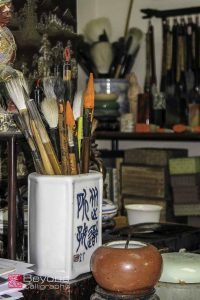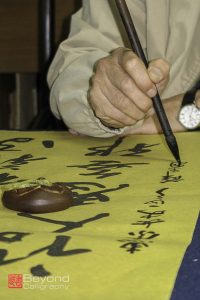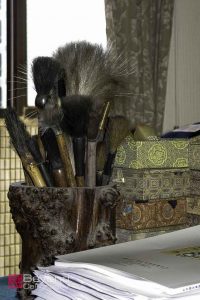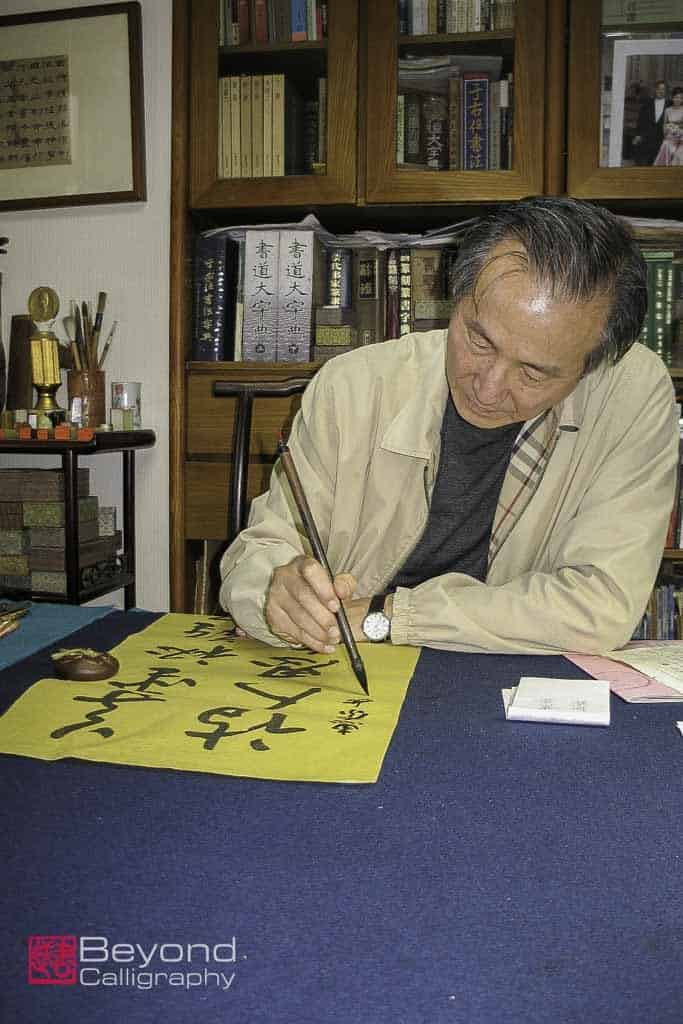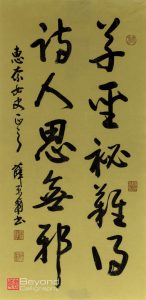The telephone call I received in Japanese while living in Japan seemed mysterious. I thought I understood what was being said and replied in Japanese, yet I was unsure. The woman said that she was a calligraphy teacher and had heard about me, a foreigner studying calligraphy, and that she would like me to meet her in Takasaki to work with her. For starters, I already had been studying with Kobayashi Sensei, my teacher for “life”, and the woman did not mention Sensei. (Nor did Sensei recognize her name when I asked her later.)
I agreed, noted the place and date and arrived in plenty of time. There were a few other foreigners there as well, but the purpose of this gathering was never explained. There were “kadai” or examples of various kinds, and we were instructed to choose and work on one or make up our own. After a few hours I was taken to another room with my work and the instructor viewed each one, placed a seal on one of them and handed me a piece of paper to fill out with my name (as it was on my passport, it said) and basic information. She then said that the work would be exhibited at the Tokyo Metropolitan Museum of Art and gave me the dates. I was dumbfounded. I thought it was likely that I had misunderstood. And if it were true, I had two more, albeit, good problems.
The exhibition was to open two days after I had to leave Japan at the end of my 90 day visa. And I had to return to the US to prepare quickly for a solo exhibition at the Duxbury Art Museum, or rather have the previously chosen work framed and ready for hanging. But the idea that my work would hang in the museum in Tokyo and that I could see it there had me rearrange my plans.
I got into high gear and decided that I would take a trip out of Japan, to Taiwan so that my visa would be extended legally, arrange to see the exhibition, then leave Japan two days later. It was rather daunting, but it was the perfect excuse to see what I had longed to see, calligraphy and other treasures spirited out of China to Taiwan and now housed in the National Palace Museum alongside the larger collection amassed over time to represent China’s art history. Their website is available in multiple languages.
I had a plan, assuming that there would be so much to see at the museum that I would spend my week there studying the treasures. I wanted to see the origins of the calligraphy I was studying. All went smoothly until I discovered something I should certainly have thought of in advance and knew well. Most museums have more than 90 percent of their collections in storage at any given time. They simply do not have the space to show their full collections, thus, they are done partially with permanent installations and partially with rotating exhibitions.
I found myself enthralled and fascinated with the calligraphy sections and spent some three days at the museum absorbing all I could. There were wonderful catalogues to purchase as well so that I could revisit the work. I purchased two of the work of SYUE Ping-nan, both Master calligrapher and seal maker. But I felt that I had seen and absorbed all that I could at the museum.
Thus it was that I found myself without a plan for the rest of my stay. While there were a myriad of things to do and see, and I did many of them, I spent some time on the computer in the hotel where I was staying to find other resources related to calligraphy. I looked up the calligrapher, but there was very little information available. I printed out some information about The Four Treasures and then enlisted the help of some of the staff whose English was excellent.
Thus it was that I found myself with an address and location of a shop of calligraphy supplies. I found the owner to be most gracious if hesitant at first until we discovered that we indeed had a rather unexpected language in common in which to confer. It was Japanese. Taiwan had been a Japanese colony between 1895 and 1945. There were many incongruous things about our conversation. As an American, I have managed to traverse what could be very uncomfortable situations when world history is concerned. In this instance, it was quite interesting to me that the shop owner said that Japan had made huge contributions to developing Taiwan and its infrastructure. But our conversation was not focused on history but on calligraphy. Fortunately, by being able to test out some ink stones (used and new), I was able to make a wonderful purchase.
With this successful outing in mind, I again asked the staff at the hotel whether or not they could contact the artist whose catalogues I was able to show them, purchased at the museum shop. And once again, after a series of phone calls, I was given two addresses. The first was “the best” bakery in Taiwan. I was instructed about what to buy there to bring as a gift to my host. I treasure the bag which contained the pastries and use it still to store some tea supplies. With my purchase in tow, I rang the bell of the studio of the Master.
The woman who had arranged for me to be received spoke in Mandarin. Neither the Master nor his wife spoke English. Yet, as I have often explained or tried to encourage others to not worry overly about communication in a particular language, we managed to spend several hours together communicating through photographs and brushes and show and tell. The translator David van der Peet has written beautifully in “The Chinese Pen” about the calligrapher/seal maker, and we are fortunate to have this information available to us here.
The article is entitled Calligraphy and Seals:Twin Beauties of Chinese Art.
After demonstrating his calligraphy, he inscribed a work to me and presented it to me with a grand and gracious smile. I am sharing its image with you along with other photographs taken to document my most unexpected encounter. May the images tell the story.
If you have had unexpected encounters, please share them below.

